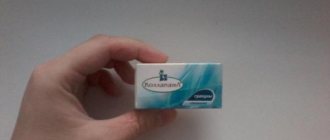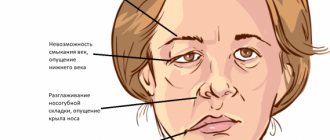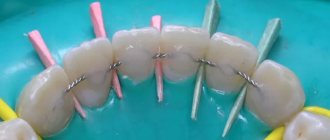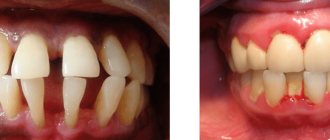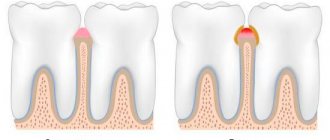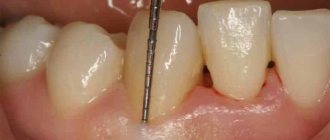Good day!
My name is Khalisat Suleymanova - I am a herbalist. At the age of 28, I cured myself of uterine cancer with herbs (read more about my experience of recovery and why I became a herbalist here: My story). Before being treated using traditional methods described on the Internet, please consult with a specialist and your doctor! This will save your time and money, since the diseases are different, the herbs and treatment methods are different, and there are also concomitant diseases, contraindications, complications, and so on. There is nothing to add yet, but if you need help in selecting herbs and treatment methods, you can find me at my contacts: Khalisat SuleymanovaInstagram page: instagram.com/fitoterapevt1
Telephone: 8
Email: [email protected]
I consult for free.
Dentists promise white teeth, healthy gums and a beautiful smile. Of course, such procedures are not cheap; not every person can afford teeth whitening and gum strengthening. But a folk remedy for dental treatment is suitable - tincture of calamus and propolis, which will cost much less.
What are adhesions in gynecology
Adhesive disease of the pelvic organs in women is a complication after which fibrinous connective tissue grows between the pelvic and abdominal organs.
In this way, the body tries to protect the source of inflammation - due to excess tissue, the fallopian tubes, uterus, ovary and intestinal loops stick together, pull tightly together, which disrupts their functions. Adhesive processes can be of several types, depending on the “neglect”:
- Formation of single thin adhesions (synechia).
- Synechiae become denser, covering up to 50% of the surface of the ovary.
- The adhesions are dense and numerous, changing the position of organs or causing their deformation.
Adhesions cause pain and disturbances in the functioning of the pelvic organs. They appear after gynecological diseases or operations and can lead to serious complications: ectopic pregnancy, infertility, frequent inflammation and more.
To prevent the occurrence of adhesions, avoid complications and prescribe competent treatment, make an appointment with the doctors of the Doctor A clinic. We employ gynecologists of the first and highest qualification categories
Calamus and propolis recipes for teeth
To prepare a medicinal tincture for teeth according to B.V. Bolotov, you need to buy a package (40 g) of calamus rhizomes, 20 g of propolis and 1 liter of vodka or alcohol at the pharmacy. The process takes place in three stages:
- Calamus tincture is being prepared. A package of crushed roots is filled with 0.5 liters of vodka. Cover with a lid and keep for 7 days.
- Propolis tincture is being prepared. 20 g of the crushed product is placed in a glass container, poured with 0.5 liters of vodka, and tightly closed with a lid. Keep for 14 to 21 days. The longer the product is infused, the more beneficial it turns out.
- The prepared products are mixed in equal proportions before each use.
You can buy propolis for teeth and calamus in the pharmacy in the form of ready-made tinctures. But their quality characteristics are usually worse than those prepared at home.
What causes adhesions to form in the pelvis
Inflammation of the pelvic organs. The disease is diagnosed in women who have suffered acute inflammation or suffer from chronic:
- colpitis;
- endometritis;
- andexite;
- parametritis and other diseases.
Operations. Adhesive disease appears in 16% of those operated for the first time and in 96% of women after the third operation. The percentage is high for laparotomy operations:
- appendectomy;
- C-section;
- removal of appendages;
- hysterectomy;
- supravaginal amputation.
Pelvic hemorrhages. The trigger is ovarian apoplexy, bleeding due to a ruptured tube during an ectopic pregnancy.
Endometriosis. The formation of fibrinous ties is provoked by endometrioid growths, which spread to the organs and peritoneum of the pelvis.
Pelvic injuries. Open and closed damage after accidents, falls from a height received at work are one of the reasons for the appearance of adhesions.
Predisposing factors. The occurrence and development of the disease is influenced by:
- invasive gynecological interventions;
- promiscuous sex life;
- late visit to the clinic.
Contraindications and precautions
Medicines prepared on the basis of calamus root are not recommended for people diagnosed with hypotension, stomach ulcers, or in the presence of constant bleeding. Also, pregnant and lactating women should not use calamus root tincture. The leaves and roots of calamus have increased biological activity, and before use, experts advise consulting with a therapist.
Components of the tincture, such as calamus and propolis, can be allergens, especially bee products. You can test the tincture on the crook of your elbow. Apply and wait 15 minutes, if nothing happens, then you can safely use the medicine.
Adhesions in gynecology: symptoms
The adhesive process can be both acute and chronic, or have a periodic nature (with periodic exacerbation of symptoms). Often, women do not notice any symptoms of adhesions in the pelvis, and the disease is discovered only when examining the possible causes of infertility.
Signs of adhesions in the pelvic cavity:
- Painful sensations in the lower abdomen, lower back, above the pubis or in the sacral area;
- Discomfort during physical activity, before menstruation, after stressful situations;
- Pain during sexual intercourse or urination;
- Intestinal disorders: diarrhea, constipation, flatulence;
- Periodic attacks of nausea and vomiting.
Symptoms may worsen when consuming foods that increase gas formation.
Application
The remedy will be useful for painful sensations of various etiologies, darkening of the enamel, and for normalizing the condition of the gums. Due to the numerous beneficial properties of propolis and calamus, it is recommended to use a tincture based on them for:
- caries;
- periodontitis;
- inflammation of the trigeminal nerve;
- jaw cyst;
- granuloma of the tooth;
- pulpitis;
- gingivitis;
- oral infections.
It is especially recommended to use the tincture before prosthetics. Regular rinsing helps strengthen dentin and prevents damage to teeth under crowns.
Diagnosis of the disease
Diagnosis of adhesions in the pelvis is carried out using various studies:
- Diagnostic laparoscopy. This method can most accurately see adhesions and assess the severity of the process. Diagnosis is carried out under local (or general) anesthesia; a small incision is made through which a camera is inserted.
- Ultrasound of the pelvic organs;
- Hysterosalpingography (performed using X-rays or ultrasound and contrast agents);
- MRI of the pelvic organs.
The necessary examination (or set of examinations) will be prescribed to you by your attending physician.
Brief description and habitat of calamus
Calamus has found wide use as a medicinal product.
It is a perennial plant that grows in swamps, near rivers and other bodies of water. Initially, its territorial position was in Asia, and then it spread to other regions, even to America and Europe. In the seventh and eighth centuries, the Tatars brought it to the Slavic lands. Since then, the grass began to be called Tatar. The plant has many other names (reed root, ginger root, etc.). The healing properties of calamus have been used since ancient times. Roman doctors more than once spoke in their treatises about calamus and its positive qualities. Its positive effect on the liver, spleen, digestive system, lungs and mucous membranes of the eyes was mentioned. In the Middle Ages, calamus was used to disinfect purulent ulcers. To do this, it was ground to a fine state. It was also used for preventive purposes during outbreaks of cholera and typhus, as well as other terrible diseases with fatal consequences.
The plant is not capable of self-pollinating; this usually occurs with the help of insects. They have a vegetative method of reproduction. Its meaning is that small shoots originate from the rhizome, then detach from it and grow on their own. The height of the plant varies from fifty to seventy centimeters. The root is quite powerful and branched, externally it is covered with a red crust, and its internal part is white.
Calamus has a specific smell that cannot be confused with others. It is pronounced, but quite pleasant.
How to treat adhesions in the pelvis
What to do if adhesions are found in the pelvis? Depending on the severity of the adhesive process, the doctor will select the appropriate treatment for you.
To treat single thin adhesions in the pelvis in women, drug therapy is used. What is usually prescribed:
- Antibiotics and antimicrobial agents (to relieve inflammation);
- Non-steroidal anti-inflammatory drugs (as a pain reliever);
- Fibrinolytic agents (for resorption of adhesions);
- Vitamins and immune system regulators (to restore immune balance);
- Hormonal drugs (in cases where adhesions are caused by endometriosis).
Additionally, physiotherapy, balneotherapy and mud therapy may be prescribed as auxiliary measures.
In more severe forms of adhesive disease, a surgical method is used to treat adhesions in the pelvis, i.e. their dissection. The most gentle surgical procedure is manipulative laparoscopy. To prevent re-formation of adhesions, hyaluronic acid is injected into the surgical area.
Recipes for using calamus
Root infusion
Twenty grams of the crushed root mixture is poured with boiling water (two hundred milliliters), covered and placed in a water bath. The process lasts fifteen minutes. Next, the container is removed from the heat and cooled for one hour, then the composition is filtered, and boiling water is added if necessary. Drink fifty milliliters per day.
Root decoction
Three teaspoons of the mixture, previously crushed, are filled with water (two hundred milliliters) and set to boil for fifteen minutes. Consume one hundred milliliters before meals. Helps with painful menstruation, neurosis and headaches.
Vodka tincture
Twenty grams of the preparation is filled with alcohol (two hundred grams), the contents are covered with a lid and infused for ten days, always in a cool room. Apply ten drops in the morning, afternoon and before bed. Taken before meals. The tincture is useful in the treatment of prostatitis, viral diseases and for improving potency.
Is it possible to get pregnant during adhesions?
Adhesions disrupt the proper functionality of the reproductive organs, which greatly reduces the chance of getting pregnant. There is a chance of pregnancy and its successful gestation, especially in cases where the adhesive process affected only one tube. But the likelihood of conception decreases, and the risk of ectopic pregnancy and miscarriage also increases.
In this case, IVF may help. The fallopian tubes are not involved in such fertilization, and a 3-5-day-old embryo is immediately implanted into the uterine cavity.
Therapeutic effect
Calamus root is an excellent antiseptic that has a positive effect on teeth and gums, as well as on the oral cavity as a whole. The range of positive effects of calamus:
- helps eliminate harmful microorganisms, has an astringent effect, helps stop the inflammatory process;
- for stomatitis, the crushed root is sprinkled on wounds and ulcers in the mouth;
- eliminates bad breath;
- Calamus root tincture helps with periodontal disease, strengthens gums and tooth enamel.
Periodontal disease is a serious disease of the oral cavity in which dental tissues are damaged with accompanying symptoms. Painful inflammation appears on the gums, and bleeding becomes more frequent. If measures are not taken, then over time the periodontal tissue will begin to deteriorate and tooth pain will appear. Cavities will begin to appear near the gums, which can cause the loss of healthy teeth.
The properties of calamus help restore gums, alleviate symptoms, and eliminate pain. One of the respected experts in traditional medicine, Bolotov, recommended rinsing your mouth with a tincture of calamus root and propolis.
Prevention of adhesions
For the prevention and treatment of adhesions, enzyme preparations based on hyaluronidase are used. Perhaps the most popular drug for the treatment of adhesions in gynecology is Longidaza suppositories.
Prevention is mostly aimed at preventing relapses of the disease or before an upcoming operation (since adhesions often appear after them).
Remember that the best prevention is regular visits to the doctor and timely diagnosis. Don’t delay until later and sign up for a pelvic ultrasound or a consultation with a gynecologist.
If you feel acute pain in the abdominal cavity or pelvic organs, do not delay visiting a doctor - prevent the development of the disease. Doctors at the Doctor A clinic will conduct an expert examination and prescribe competent treatment. Call or make an appointment online.
Recommendations for the use of tinctures
After making a herbal infusion with alcohol, the question arises - how to properly use the drug in order to get the maximum benefit from it. For convenience, it is customary to mix alcohol tincture with a small amount of water. In this case, the medicine will not burn the mucous membrane so much. Rinsing your mouth should be done for two minutes.
Afterwards, the mixture needs to be spat out, as it contains an accumulation of all microbes and harmful bacteria. If you experience pain in your teeth, you can rinse more than once a day. It is also recommended to carry out the procedure before bedtime. Due to the strength of alcohol, calamus root extract penetrates deeply and fills small cracks.
Preventing the appearance of a cyst in a tooth
It should be noted that prevention is better than the best treatment. As you know, a cyst is a kind of protective reaction of the body to inflammation, that is, it is necessary to prevent inflammation in general. As for dental cysts, in order to prevent its occurrence, it is recommended to eat regular garlic more often, which has constant disinfecting properties and is a natural antiseptic. And of course, it is necessary to visit a good and inexpensive dentist often (at least once every six months) and monitor the impeccable health of your teeth and gums. If there is an initial stage of dental caries or any periodontal disease, you need to urgently treat and eliminate the symptoms of these dental ailments.
Tooth cyst, treatment
Treatment of dental cysts today is carried out either by therapeutic or surgical methods.
Therapeutic methods include unfilling of tooth canals, thorough mechanical and medicinal treatment of the canals, followed by three-dimensional filling of the canals along the entire length
A dental cyst, which was treated using modern technologies by an experienced endodontist (a specialist in the treatment of dental canals), has a good chance of completely disappearing.
Treatment of pulpitis at the Best Dentistry clinic is carried out by experienced doctors with at least 10 years of experience in therapeutic dentistry.
For this purpose, only the most modern equipment is used, including apex locators and endodontic tips for three-dimensional hermetic filling of tooth canals.
In addition, for mechanical and medicinal treatment of tooth canals with pulpitis, we use highly effective sterilization techniques such as laser and ultrasound.
Tooth cyst before and after treatment at the Best Dentistry clinic
Apex locator with endodontic tip
Mechanical treatment of the canal involves its expansion, smoothing out uneven walls, polishing the canal walls for deep, but at the same time safe insertion of the endodontic instrument and filling the canal with filling material.
Device for three-dimensional filling of tooth canals
Medical treatment of tooth canals means the removal of decayed remnants of the neurovascular bundle of the tooth and is a very important component of treatment, since it prevents infection from entering the tissue adjacent to the tooth.
As already mentioned, for medicinal treatment of canals, in addition to antiseptic solutions, we use additional modern methods - treatment of the canal walls with laser and ultrasound, which ensure almost complete sterilization of the tooth canals.
Tooth canal filling is performed in our clinic not in one visit, as in most clinics, but in two stages. First, a temporary filling material is introduced into the canal, which has a pronounced antiseptic and anti-inflammatory effect, and after several days, permanent material is introduced that hermetically fills the canal.
CALMARUS (ordinary calamus root) –ACORUS CALAMUS L.
Sem. aroids - Araceae
DESCRIPTION. A perennial herbaceous plant with a thick yellow creeping rhizome up to 30 cm long. The rhizome at the ends of its branches develops bunches of narrow, bright green linear-xiphoid leaves, 60-120 cm long.
The stem has a fleshy ear-inflorescence, from the base of which a green covering leaf extends, which is like a continuation of the stem.
The spadix is planted with greenish-yellow flowers, each of 6 membranous, with slightly thickened and inwardly curved tips of the leaves, 6 stamens. The fruit is an oblong, multi-seeded green or reddish drying berry. Blooms from the second half of May to July.
RAW MATERIALS. Medicinal raw materials - dried rhizomes of calamus (Rhizoma Calami). They are collected in the fall, when the water level in reservoirs drops and they can be removed from the silt with a rake or pitchfork. The rhizomes are washed, the leaves and roots are trimmed, cut into transverse pieces, and thicker ones are split lengthwise. Air and heat drying of rhizomes is allowed at a temperature not exceeding 25-30ºС. The smell is pleasant, aromatic, the taste is spicy-bitter. Shelf life - up to 3 years.
SPREADING. Calamus is found in the North Caucasus, Russia and Kuban. It grows along the banks of rivers, streams, lakes, ponds, on muddy soil and in wetlands, forming continuous thickets.
CHEMICAL COMPOSITION. Rhizomes contain up to 4.8% essential oil of complex composition. It includes: d-alpha-pinene, d-camphene, d-camphor, borneol, eugenol, methyleugenone, asarone, beta-asarone, calamen, sesquiterpene ketone acorenone, caryophyllene, proazulene and other terpenoids. In addition to essential oil, the rhizomes contain: bitter glycoside acorin, tannins, ascorbic acid. The leaves are rich in essential oil, starch and tannins.
APPLICATION. The substances contained in the rhizomes of calamus increase the excitability of taste nerves, enhance the reflex secretion of gastric juice, increase the biliary function of the liver, the tone of the gallbladder and diuresis, and also have anti-inflammatory and fungistatic effects. Calamus roots have long been used during epidemics of influenza, typhus, and cholera as a preventive measure against infection with these diseases. More often, decoctions and tinctures of calamus rhizomes are used. The decoction is used for hair loss, external wounds and ulcers are washed with the tincture, and the powder from the rhizome is used as a powder; it relieves heartburn and toothache well. For medicinal purposes, a decoction of calamus rhizomes is used internally as an aromatic bitterness to stimulate appetite for gastrointestinal diseases, gastritis, colitis, hepatitis and cholecystitis, and also as a tonic for depression of the central nervous system. Included in bitter tinctures, gastric preparations, Vikair and Vikalin tablets, used for gastric and duodenal ulcers, as well as for hyperacid gastritis.
The infusion and calamus decoction are used externally for rinsing, and the powder is used as a powder for purulent wounds and ulcers.
In folk medicine, calamus is used to treat scurvy, gout, influenza, cholera, typhus, jaundice, scrofula, diathesis, malaria, rickets, kidney diseases, inflammation of the bladder and various female diseases (as an internal and external remedy in the form of sitz baths The rhizomes and leaves of calamus are used for baths).
RECIPES
1. Infusion:
a) pour 15 g of crushed rhizome with 1 glass of boiling water, leave for up to 2 hours, strain. Take 1 tbsp. spoon 3 times a day before meals for flu, gout, inflammation of the kidneys, bladder, to stimulate appetite for gastrointestinal diseases;
b) pour 15 g of calamus rhizome with 1 glass of cold boiled water, leave for 8 hours, strain. Take 1 tbsp. spoon 3 times a day before meals for various gastrointestinal diseases, diseases of the liver, kidneys, gall and bladder and as a sedative.
2. Decoction:
Boil 15 g of dry rhizomes for 15 minutes in 3 glasses of water, leave for 1-2 hours in a tightly sealed container, strain. Take ½ glass 3 times a day 30 minutes before meals for indigestion, gastric ulcers, intestines.
3. Tincture:
Pour 20 g of crushed rhizome with 100 ml of alcohol, leave for 8 days in a warm place, shaking frequently, strain. Take 20-30 drops with water 2 times a day for diseases of the liver, kidneys, gall and bladder, and gastrointestinal diseases. Apply a piece of cotton wool to aching teeth.
4. Powder
take 0.2-0.5 g of rhizomes 3 times a day with water for heartburn.
5. Infusion
mixtures of calamus rhizomes and oak bark in equal parts are taken for alveolar pyorrhea and bad breath.
USE IN NUTRITION. Aromatic jam is prepared from the leaves that come off the rhizome. Calamus rhizome can replace cinnamon, nutmeg and pepper.
Calamus salad
Select the inner young leaves of the plant, cut into strips, add onion, sour cream, and salt to taste.
Candied calamus roots
Place fresh calamus roots, 3-4 cm long, into thick syrup, splitting them into four parts, and steam for 5-10 minutes. Remove from syrup and dry. Then place in glass jars for storage in a dry place.
Pancakes made from calamus leaves
Calamus leaf powder is added to the dough prepared for baking pancakes. Bake in vegetable oil.
Calamus decoction
Take 20 g of dry calamus rhizomes, pour 1 liter of boiling water. Boil for 5 minutes and leave for 24 hours. Use for flavoring baked goods, salads, first courses.
Kvass with calamus
Add the prepared decoction of calamus roots to the kvass obtained in the usual way: 1 glass of decoction per 3 liters of kvass.
Conservative and surgical treatment of cysts
In the early stages, in the absence of complications, a conservative method is acceptable. The root canal is drilled and cleaned. The capsule with pus is opened and cleaned, and a composition with an antibiotic is poured inside. Next, a bone tissue regeneration paste is applied and a filling is installed. A control check after 6 months demonstrates the absence of a cyst on an x-ray in 80% of cases
Surgical treatment is prescribed if there is no result. With the help of cystectomy, the affected part of the tooth and the capsule with pus are completely removed. Cystectomy is an operation that not all dental surgeons can do. Hemisection is often used, which gives a 100% result and is prescribed for severe root damage. All affected tissue is removed, and the appearance of the tooth is restored with a crown or composite composition.

